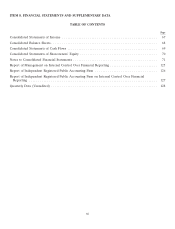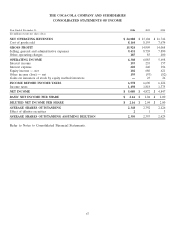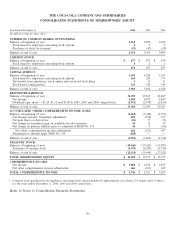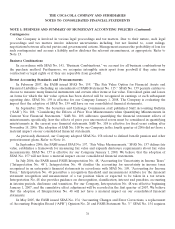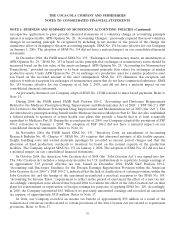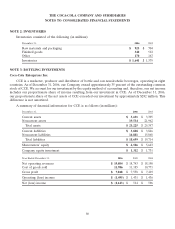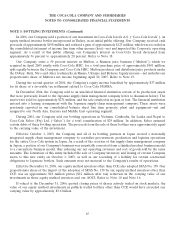Coca Cola 2006 Annual Report Download - page 78
Download and view the complete annual report
Please find page 78 of the 2006 Coca Cola annual report below. You can navigate through the pages in the report by either clicking on the pages listed below, or by using the keyword search tool below to find specific information within the annual report.THE COCA-COLA COMPANY AND SUBSIDIARIES
NOTES TO CONSOLIDATED FINANCIAL STATEMENTS
NOTE 1: BUSINESS AND SUMMARY OF SIGNIFICANT ACCOUNTING POLICIES (Continued)
noncurrent other assets and are being amortized over the remaining periods to be directly benefited, which
range from 1 to 12 years. Amortization expense for infrastructure programs was approximately $136 million,
$134 million and $136 million for the years ended December 31, 2006, 2005 and 2004, respectively. Refer to
heading ‘‘Revenue Recognition,’’ above, and Note 3.
Property, Plant and Equipment
Property, plant and equipment are stated at cost. Repair and maintenance costs that do not improve service
potential or extend economic life are expensed as incurred. Depreciation is recorded principally by the
straight-line method over the estimated useful lives of our assets, which generally have the following ranges:
buildings and improvements: 40 years or less; machinery and equipment: 15 years or less; containers: 10 years or
less. Land is not depreciated, and construction in progress is not depreciated until ready for service and
capitalized. Leasehold improvements are amortized using the straight-line method over the shorter of the
remaining lease term, including renewals that are deemed to be reasonably assured, or the estimated useful life
of the improvement. Depreciation expense totaled approximately $763 million, $752 million and $715 million for
the years ended December 31, 2006, 2005 and 2004, respectively. Amortization expense for leasehold
improvements totaled approximately $21 million, $17 million and $7 million for the years ended December 31,
2006, 2005 and 2004, respectively. Refer to Note 5.
Management assesses the recoverability of the carrying amount of property, plant and equipment if certain
events or changes in circumstances indicate that the carrying value of such assets may not be recoverable, such as
a significant decrease in market value of the assets or a significant change in the business conditions in a
particular market. If we determine that the carrying value of an asset is not recoverable based on expected
undiscounted future cash flows, excluding interest charges, we record an impairment loss equal to the excess of
the carrying amount of the asset over its fair value.
Goodwill, Trademarks and Other Intangible Assets
In accordance with SFAS No. 142, ‘‘Goodwill and Other Intangible Assets,’’ we classify intangible assets
into three categories: (1) intangible assets with definite lives subject to amortization, (2) intangible assets with
indefinite lives not subject to amortization, and (3) goodwill. We test intangible assets with definite lives for
impairment if conditions exist that indicate the carrying value may not be recoverable. Such conditions may
include an economic downturn in a geographic market or a change in the assessment of future operations. We
record an impairment charge when the carrying value of the definite lived intangible asset is not recoverable by
the cash flows generated from the use of the asset.
Intangible assets with indefinite lives and goodwill are not amortized. We test these intangible assets and
goodwill for impairment at least annually or more frequently if events or circumstances indicate that such
intangible assets or goodwill might be impaired. Such tests for impairment are also required for intangible assets
with indefinite lives and/or goodwill recorded by our equity method investees. All goodwill is assigned to
reporting units, which are one level below our operating segments. Goodwill is assigned to the reporting unit
that benefits from the synergies arising from each business combination. We perform our impairment tests of
goodwill at our reporting unit level. Such impairment tests for goodwill include comparing the fair value of the
respective reporting unit with its carrying value, including goodwill. We use a variety of methodologies in
conducting these impairment tests, including discounted cash flow analyses with a number of scenarios, where
applicable, that are weighted based on the probability of different outcomes. When appropriate, we consider the
76


